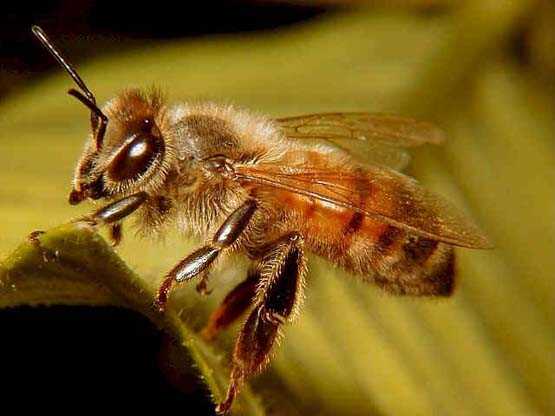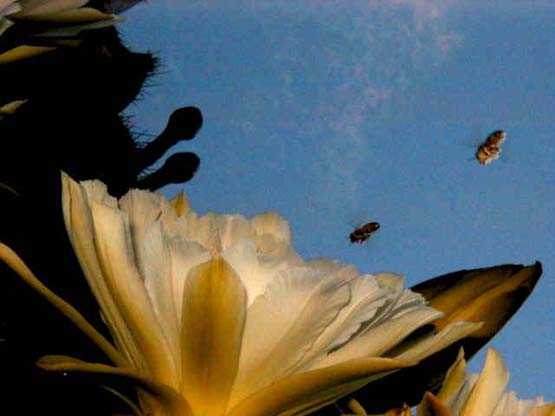|
After six weeks writing about the fascinating world of the bees, I have
the feeling that it’s about time, after this week, to think of something
new.
Not
because everything about this amazing, amusing and profitable insect has
been said or is even known yet.
In
fact, all the experts agree that it’s only recently that we have really
started to discover and understand part of their most intimate secrets
and the enormous amount of unexpected possibilities that bees do in
their everyday lives and can still teach us.
But
there are other questions and actual political-ecological problems on
our Islands, and unfortunately all over the World, that also require our
attention and time.
Our
strongest determination - if not to work them out - is at least to be
able to show them as we see them, without political or economical
disguises, so we all can see them with our own eyes and therefore make
up our own opinions and conclusions about what sort of future we look
for and what is the real meaning when we talk about “Quality of
Life”.
I
would very much prefer to continue with the bees. There is still so much
to say about them, even though they can sting you to death with their
poisonous sting if you don’t treat them right and fair.
They
don’t seem to be offended about what I write on them (unlike the
politicians). In fact, they keep offering the best of their production
and seem to be friendlier every day. And I much prefer to make friends
than enemies, though they say there is no important task done without
having important opponents and some dangerous and twisted enemies, far
more poisonous then any other creature in the world.

So,
we carry on with bees and their products for this week.
It
was the honey that made the bees, so soon in pre-history, so popular and
wanted by the humans. Honey was the first and only reason for many
generations and was why man was prepared to support the painful sting of
the bee; the compensation was worthwhile.
Bees
that lick the nectar, pollen, sugar and other substances from flowers
and other parts of the plants, as everyone knows, produce honey. They
keep it in a craw or honey bag that bees possess just for this purpose,
in which all these substances get mixed with its “saliva” and other body
fluids before they spit it back inside the cells in the panel’s hive,
already transformed into honey.
Honey is a compound basically of “dextrose” and “laevulose” (70%), water
(20%), sugar, from sugar cane, gums, resins, colorants, small amounts of
minerals, aromatic essences and pollen. The aroma, taste and colour come
mainly from the type of flowers that the bees visit most in its
production.
The
spring honey is normally the best and most wanted; the “virgin honey”,
stocked in thin pure white new cells, only used for this purpose.
Then
comes the honey collected in the summer. Autumn produces the lowest
quality, at least in this part of the world. It is also interesting to
notice that honey can also be poisonous, like the “Trebisonda honey”
(Jenofonte, “Anabasis”) produced by the poisonous flower “Azalea
Pontiac”.
This
rich and healthy aliment, if eaten in the right doses, was for many
centuries, even millenniums, one of the very few substances that humans
had to sweeten any food or drink. Therefore it was basically used by the
higher classes or by the peasants that produced their own, but even them
used to sell or change it for any other most needed materials, because
of its price.
With
the arrival of sugar, made in industrial ways from the sugar cane,
around the XIV-XV centuries, honey lost most of its importance and uses,
as well as its price. Then the Apiculture industry dropped drastically
and even disappeared in some countries, but - little by little - it came
back as a rich, healthy and delicate aliment.
Recent scientific studies have proved that eating daily a certain amount
of honey helps to prevent and cure several illnesses, including chronic
heart disease.
Wax
was the second product from the bees to be used by man. It is produced
by some glands that bees possess in their abdomen, as it is known, which
bees used for the construction of the hive’s panels. Chemically, it is
considered an “Esteres”. It contains alcohol, greasy acids, free acids
and hydrocarbons. The bee-wax is mild at 62-65ºC and floats on water.
This used to be the most common way to obtain it, putting the wax with
water and heating it up to this temperature. Initially it was used to
make candles, as cosmetics, mixed up with colorants and aromas, and to
waterproof leather and cloth.
At
present, the “virgin-bee-wax” is used in many industrial processes,
including electronics and pharmacy.
Pollens have been, together with the “Propolis”, the last products from
bees to be used and commercialised by man. Both have proved to be a very
interesting and complete aliment, even medicine for some, as an elixir
for the modern dietetics.
They
contain “Amino-acids” and “Oligo-elements” as well as some vitamins.
Everybody knows what pollen is. Bees stock it in cells in the panels in
important quantities, as part of their own food, and the “propolis” is a
mixture of resins and gums that bees produce from the new buds of some
trees and plants which bees use as “cement” to fix the panels within the
hives and to repair any cracks or hole in it. Its price and importance
in the market is bigger everyday.
But
the most expensive (more expensive then gold) and real “Star-product” of
the bee is nowadays the “Royal-jelly”, a substance produced by young
bees (only in the first three weeks of their life) like sweat or milk,
in glands that they posses in their heads. This is a very complete and
still mysterious aliment; some biologists compare it with the
“pigeon-milk”, the exclusive aliment that pigeons produce in their craw
to feed new-born pigeons, with a similar chemical composition.
Bees
use it to feed the new larvae for the first two or three days, and it is
also the only food that the bee-queen will eat all her life.
The
fact that the queens can live up to five years, only eating this stuff,
compares to the seven to eight weeks - six months at the most - if they
live resting inside the hive in the winter that normal bees can live.
It’s what makes this substance so mysterious and appreciated by man.
As
we have said at the beginning of this article, there is still a lot to
say about bees; almost anything they do will be enough to write books
and books about it, and still we are learning new things about them.
We
haven’t spoken yet about their natural enemies, most common illnesses,
the fabulous way that they dance to communicate among themselves, the
new tools and techniques to extract the honey or the use of new sciences
in pollination and other branches, like in medicine, where the poison of
its sting is being used to tread several illnesses, especially
rheumatism, arthritis problems, allergies and other poisonous
intoxication.
For
instance, the USA army (Americans, always so romantic) have started to
use bees as haunts to detect explosives in very small quantities. Bees
are far better then dogs for this job, and they can reach the places
dogs can’t, so no doubt we will soon see bees in marine-style uniform.
The problem is that bees don’t do night-share and they don’t work on
stormy days either).
We
haven’t either spoken about the actual situation of the Apiculture in
our Islands; however this is a subject that I expect to write about as
soon as I have the up date information. Until then.... Beeeeezzzzzeeeeee
(Good Bye).
 |